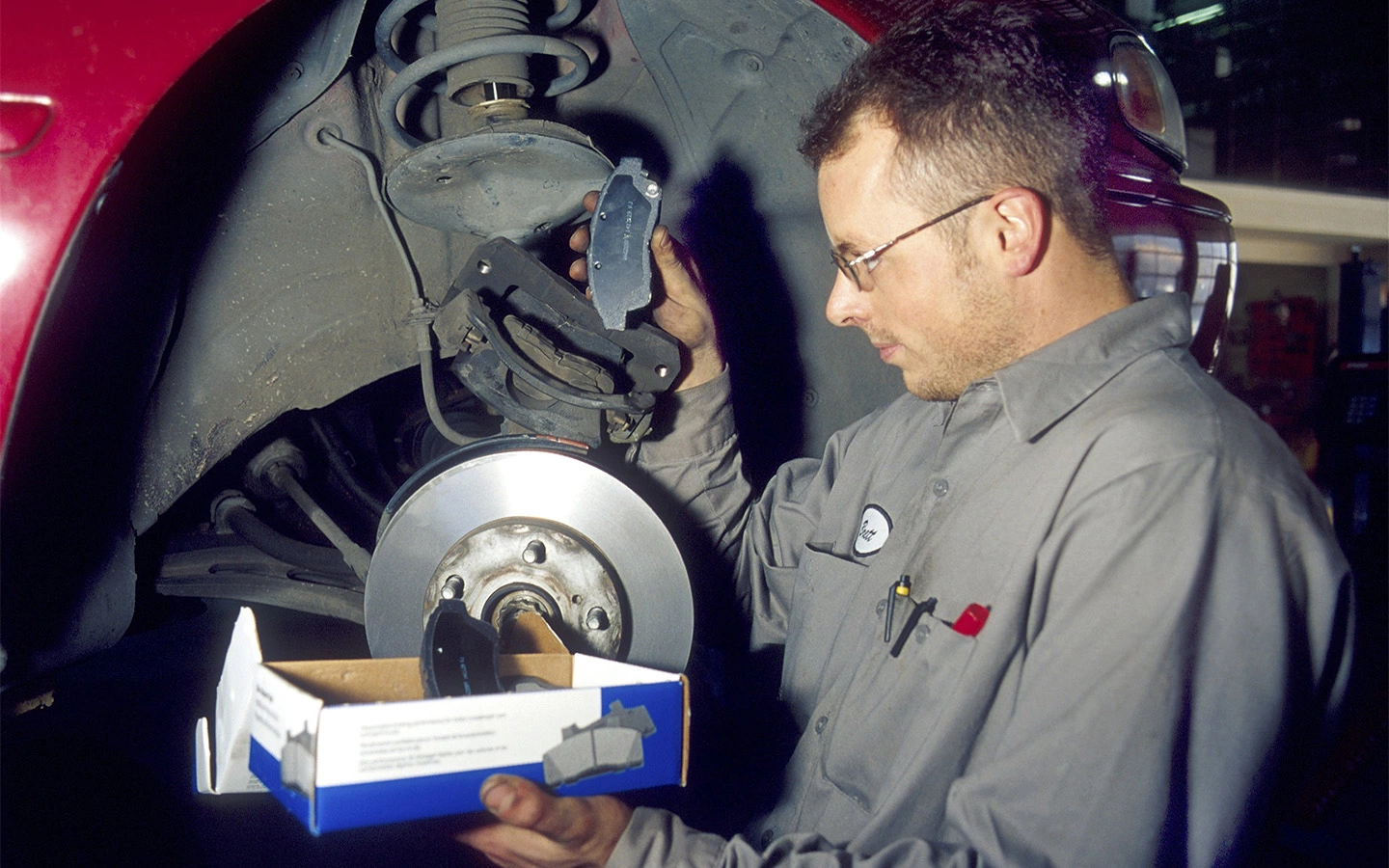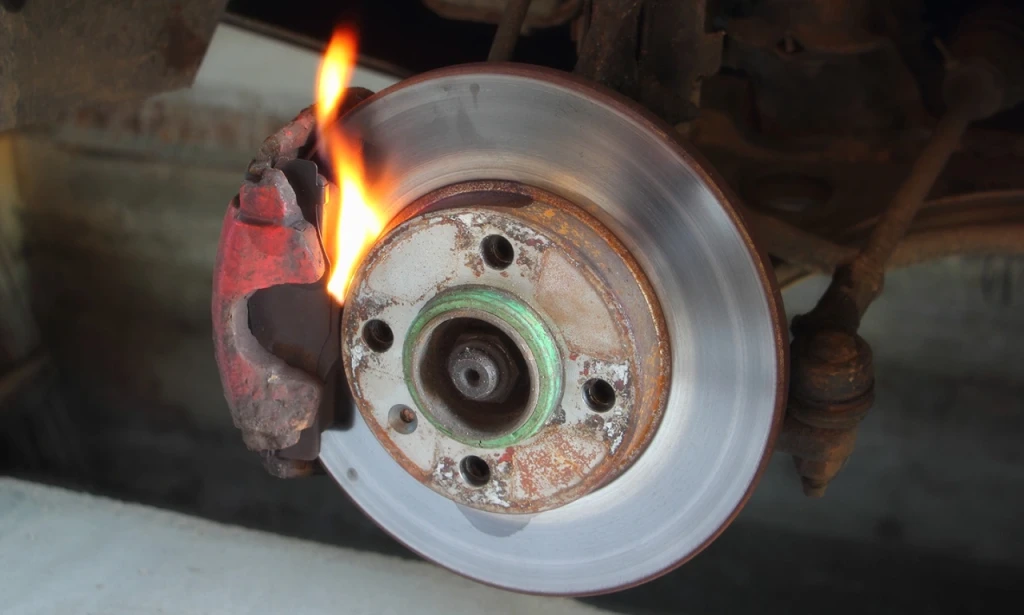The arrival of hot weather affects not only the cooling system, but also the brakes. Let's take a look at how to avoid overheating your discs and what to do if it does happen.
 Why brake discs overheat and what this can lead to | Photo: ilmarinfoto / Shutterstock / FOTODOM
Why brake discs overheat and what this can lead to | Photo: ilmarinfoto / Shutterstock / FOTODOM
Signs of brake disc overheating
The main signs of disc overheating are as follows:
- The brake pedal becomes ‘spongy’. That is, its travel increases, and it becomes more responsive. At the same time, braking efficiency decreases: you need to press harder to slow down, usually.
- A characteristic smell of burnt brake pads and hot metal.
- Sometimes there are squeaking and grinding noises coming from the brake mechanisms (calipers).
- Visual changes to the brake discs. Overheated metal turns bluish, often with cracking on the surface — a characteristic ‘dry earth’ effect.
- Steering wheel vibration during braking due to disc deformation. ‘Waves’ on these parts are the result of exposure to very high temperatures.
Why brake discs overheat
Malfunctioning of the brake system, which can result in overheating, is possible for several reasons.
- Brake caliper sticking. As a result of dirt getting into the working mechanisms (usually due to a torn dust cover), the caliper piston that presses the pad may stick. As a result, even after the brake pedal is released, the pad does not move away from the disc sufficiently, causing constant friction and overheating.
- Harsh driving conditions. This is always a combination of factors. For example, when a car is towing a trailer in hot weather, and the route has many long descents.
- Poor quality pads or discs. In this case, the braking performance is insufficient, so the driver has to press the brake harder and more often, causing overheating.
- Driving style that does not match the capabilities of the brakes. This happens when the driver starts to treat their car like a sports car. For a normal car, just a couple of sharp braking manoeuvres in a row at speed in hot weather is enough to push average brakes to their limit. If you continue to do so, the brakes will overheat, resulting in irreversible damage to the discs.
 Why brake discs overheat and what this can lead to | Foto: BLKstudio / Shutterstock / FOTODOM
Why brake discs overheat and what this can lead to | Foto: BLKstudio / Shutterstock / FOTODOM
Why do rear brake discs overheat?
The rear brakes deserve a special mention — they often overheat independently of the front brakes. This usually happens due to jamming or incorrect adjustment of the handbrake. In this case, the working brake system (from the pedal) is in order, but the parking brake (handbrake) always partially holds the car and heats the rear discs.
Why do brake discs heat up after replacement?
After replacing both discs and pads, the parts will wear in for a while (up to several dozen kilometres). During this period, the brake mechanisms may indeed heat up slightly, even without a load. However, this effect is short-lived and mild.
It is another matter when the heating is severe (even the wheel rim heats up) — this is no longer normal and can lead to breakdowns. In most cases, the culprit is the same: the caliper pistons sticking due to a damaged dust cover. This is how it works.
On an old disc, the thickness of which decreased with wear, the pistons worked with a strong protrusion from the caliper. This was especially true when the pads were nearing the end of their service life. As soon as new parts were installed (the pads are often replaced along with the discs), the increased overall thickness of the disc and pads pushed the piston back into the caliper housing. But after several years of operation in the same position, the surface of the piston that was ‘exposed’ became covered with dirt and corrosion — this happens when the dust cover is damaged, often even imperceptible to the eye. As a result, in their new working position (sunken into the caliper), the pistons stick, which leads to the brake discs heating up.
The same thing happens when replacing the pads. If the old ones were worn down to the metal and the dust cover was damaged, then after replacing the pads (and thus changing the working position of the pistons to a more recessed position), sticking and heating may occur.
 Why brake discs overheat and what this can lead to | Foto: David R. Frazier / Danita Delimont / Global Look Press
Why brake discs overheat and what this can lead to | Foto: David R. Frazier / Danita Delimont / Global Look Press
Brake discs are overheating: what to do.
Globally, the problem of brake system overheating can be solved in two ways: either by fixing the malfunction or by adjusting the driving style.
An alternative to the second method is to upgrade (tune) the brakes so that they can withstand the owner's driving style. Based on the above, the typical ways to combat overheating are as follows.
- Eliminating caliper sticking. In most cases, it is sufficient to clean and overhaul them using special repair kits.
- Adjusting the handbrake — if the problem is that it is ‘sticking’. There is a special algorithm for adjusting the handbrake, which is described in the Repair Manual.
- Installing high-quality parts (pads and discs) — if the problem is not with the calipers or the handbrake.
- Modification of the brake system. Brake tuning can include either the replacement of only the executive mechanisms — calipers, discs, and pads — or a complete upgrade, including a powerful vacuum booster, reinforced hoses, etc.
Consequences of brake disc overheating
Firstly, warped discs do not work as effectively and increase the braking distance during emergency braking from speed.
Secondly, constant vibrations hurt both comfort and the service life of other components and systems, such as the steering.
Finally, if you continue to use a severely overheated disc, it may eventually burst or even disintegrate. The consequences of such a scenario are obvious.
 Why brake discs overheat and what this can lead to | Foto: BIKERUM
Why brake discs overheat and what this can lead to | Foto: BIKERUM
Read my articles
https://stattya.com/how-when-and-what-type-of-brake-fluid-should-be-changed-744
https://stattya.com/valve-adjustment-what-it-is-and-why-it-is-necessary-651
https://stattya.com/brake-caliper-how-it-works-and-why-it-is-important-659
https://stattya.com/how-an-oil-pump-works-functions-common-failures-repair-tips-260
https://stattya.com/what-to-do-if-your-battery-dies-8-ways-to-start-your-car-658


You must be logged in to post a comment.